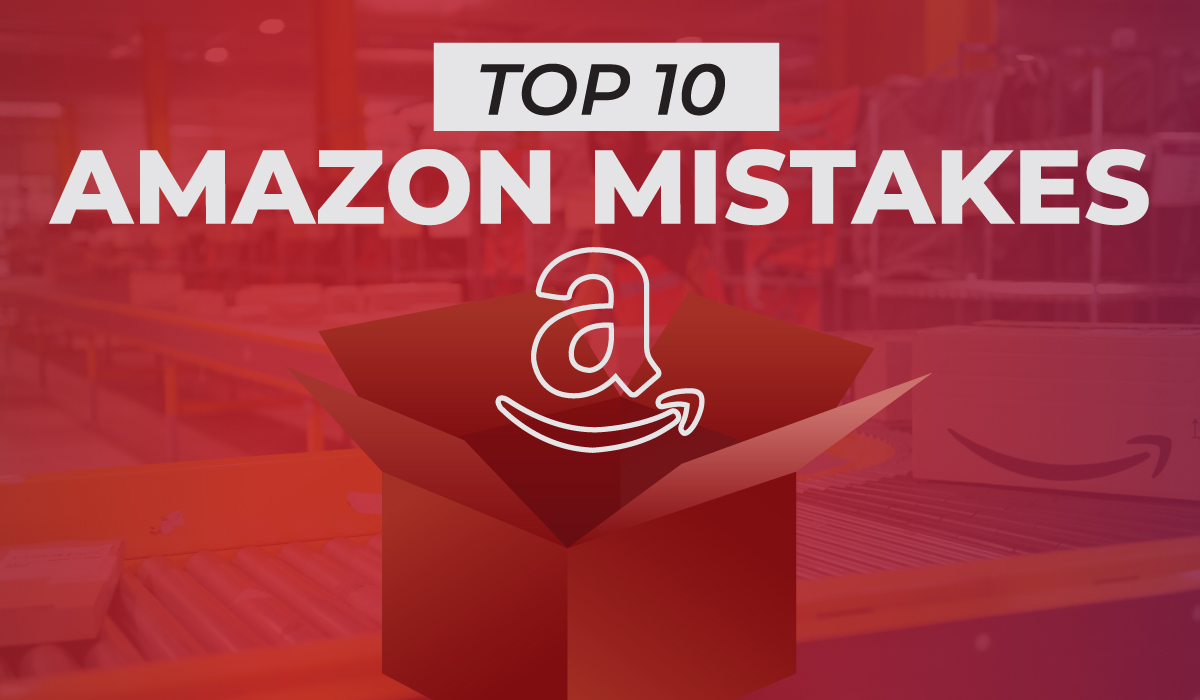
Top 10 Mistakes Amazon Sellers are Making
E-commerce is an incredibly lucrative industry nowadays, as more and more consumers transition from shopping at brick-and-mortar stores to making purchases online. Amazon, the eighth-largest United States corporation in terms of total revenue, is an obvious choice for vendors looking to expand their market reach.
While it’s possible for brands to generate tremendous amounts of revenue on Amazon, there are also many pitfalls that can plague and entangle inexperienced vendors. Each aspect of the online retail operation must be formulated and executed with precision in order to attract and retain customers, as well as maintain high product reviews. Starting with a viable marketing plan, a seller must incorporate precise, strategic product descriptions and photographs, price products competitively, provide seamless customer support and fulfillment, all while navigating the rules and restrictions set forth by Amazon in order to avoid suspension or termination.
This article, while by no means exhaustive, is an introductory guide to the top 10 mistakes that Amazon sellers should avoid making.
Amazon Seller Mistake #1.
Manipulating Reviews
It’s no secret that Amazon’s product sales are directly correlated to reviews. Product ratings are buyers’ first point of reference in determining the quality of a product; thus, vendors will compete to establish the highest possible rating in order to bump their listing to the top of the results.
Due to the importance of reviews, marketing leaders can be tempted to game the system and artificially inflate the quantity of four and five-star reviews for a product. There are a number of different ways to manipulate product ratings, such as using click farms, asking friends and family to write reviews, and offering free or discounted products in exchange for positive ratings.
While these strategies may be effective for boosting sales in the short term, the consequences can be severe if Amazon discovers that you have violated their review manipulation policy. Failure to adhere to the policy may result in account suspension or termination, in addition to possible legal ramifications. Keep in mind that it is acceptable to email customers after their purchase and ask them to leave an “honest” review, but not a “positive” review, since urging them to write a specific type of review would be considered a violation by Amazon.
Amazon Seller Mistake #2.
Lack of Timely and Effective Customer Service
Providing quality customer service is an essential aspect of e-commerce. Vendors who are driven to satisfy customers’ needs and concerns are much more likely to retain clientele and garner high ratings. In addition, friendly customer interactions humanize the online shopping experience, making buyers feel valued and more comfortable with their purchases.
Sellers on Amazon are required to respond to customer queries within a 24-hour window; repeated failures to respond in time can also result in account suspension. This makes it critical to maintain a low Late Response Rate, which is tracked and calculated by Amazon.
Amazon Seller Mistake #3.
Improper Product Descriptions
Due to the crowded and competitive nature of Amazon marketplace, it’s vital to provide optimized product details so that buyers can find their way to your store. Since online shoppers have become quite savvy at researching and comparing products, it is very important to include precise product titles, descriptions, sizes, and colors. Merchants and their marketing leaders should provide as many details as possible on the exact model, materials, and any special features of their products while leveraging the optimized search terms that are capable of bumping a product title to the top of search results with a higher volume of monthly searches.
As with other forms of marketing, the first step to writing strong sales copy is to know your target audience, rather than focusing exclusively on your product. Merchants and their marketing leaders must understand their audience demographics. Marketing leaders must anticipate customers’ wants, pain points, and concerns by considering competitor reviews and their products’ customer questions on Amazon. Then, write a strong product description with concrete descriptions, strategically placed keywords and keyphrases, and vivid sensory language in order to entice visitors.
Amazon Seller Mistake #4.
Insufficient Market Research
Who are your competitors and how are their products priced? What are the strengths and weaknesses of their goods? Are their Amazon reviews generally positive or negative? These are all important questions to ask before putting your own product on the market.
It can be insightful to check Amazon’s Best Seller lists, trending items, and the “customers also bought” section in order to see which companies you will be competing against, and how your own products match up against the current top sellers. Google Trends and Keyword Planner can also be useful for determining current market trends so that you have a better idea of how to list your products on Amazon.
Amazon Seller Mistake #5.
Fulfillment Errors
Amazon merchants are responsible for fulfilling orders at competitive shipping prices and times, since Amazon Prime members expect free shipping and two-day delivery. These challenges can cause logistical nightmares for any eCommerce operation that isn’t prepared.
There are two other options for Amazon sellers who would like to outsource their fulfillment operation: drop shipping and Fulfillment by Amazon (FBA). The other alternative, Fulfillment by Amazon, involves sending your inventory to an Amazon fulfillment center, where they will then handle shipping, customer service, and returns. Allowing Amazon to take care of your logistics can be extremely helpful, since they offer free shipping to Prime members and provide exceptional customer service when dealing with returns and refunds. However, FBA costs can add up, since you are paying Amazon for all of the services mentioned above, as well as storage per cubic foot per month.
Merchants looking into third party fulfillment services should confirm that the company’s warehouse staff are trained and up to date on Amazon’s latest shipping policies. Regardless of the fulfillment strategy a merchant chooses, they must be sure to get orders out the door quickly and accurately to maintain their good standing with Amazon.
Amazon Seller Mistake #6.
Underestimating Operating Costs
There are a variety of operating costs attached to running an eCommerce business. Individual sellers on Amazon pay an account fee of $0.99 for each item sold, while professional sellers pay a flat subscription rate of $39.99 per month regardless of items sold. It then follows that businesses selling more than 40 items per month should pay for the professional subscription.
On top of the account fee, there’s also a referral fee for each item sold, ranging from 6% to 20%, with most sellers paying 15% on average. The percentage depends on the product category and selling price. For example, there is a 20% referral fee for jewelry, while the rate for cell phones is much lower at 8%. There is an additional variable closing fee of $1.80 per item for products under the media category (including books, DVDs, music, video games, and game accessories).
Finally, there are also state and local sales taxes to consider, as well as overhead costs for shipping and inventory. Merchants that fail to properly account for these costs will find themselves in the red- and eventually, out of business.
Amazon Seller Mistake #7.
Lack of Marketing Strategy
Having an actionable marketing plan is an important aspect of any eCommerce operation. Merchants and their marketing leaders are wise to hire a digital marketing agency to support the in-house team with strategy and additional resources for implementation, such as designing out custom Amazon storefronts, optimizing paid ads, and integrating the brand’s email and social media strategies.
A full-service digital marketing agency can also help you take professional photos of your products, which is crucial since buyers will make snap judgments on the value of products based on the quality of the listing’s images. Be sure to add images of products from different angles, as well as labels, comparison charts, and add video when possible. Merchants should upload images that are 2,000 x 2,000 pixels so that buyers can take advantage of the zoom feature.
Amazon Seller Mistake #8.
Breaking Intellectual Property or Selling Inauthentic Items
Apart from review manipulation, Amazon also has strict policies for sellers who violate intellectual property regulations. Copyright, trademark, trade dress, and patent infringements can all result in account suspension. Third party sellers and their marketing leaders need to ensure that they have the legal right to publish their product descriptions, images, logos, videos, background music, and icons.
Selling inauthentic items also violates Amazon seller policy. Any product that doesn’t come from an authorized supplier, isn’t accurately listed, or doesn’t come in original packaging can result in account suspension. The appeals process is long and cumbersome, so merchants are better off erring on the side of caution when it comes to sourcing their products.
Amazon Seller Mistake #9.
Selling Restricted Products
This sounds obvious, but time and time again a merchant contacts us to see if we can determine why Amazon suspended their account- only to find out that they were selling restricted products. Amazon has an extensive list of restricted products in various categories, due to local laws and regulations, as well as Amazon’s own policies. Many product categories have wide-ranging regulations, especially consumables such as dietary supplements, cosmetic products, animal products, and food and beverage products.
There are also specific restrictions in categories such as fine art, automotive accessories, jewelry, lighting, and electronics. Be sure to confirm each product in your Amazon store is a permitted listing before putting them on the market.
Amazon Seller Mistake #10.
Offering Lower Prices on Amazon Than Your Own Website
Everyone knows that Amazon is a highly competitive marketplace for sellers, but eCommerce brands must resist the urge to cannibalize their own sales by offering lower prices in their Amazon stores than their own websites, or else they risk training their own customers to shop at Amazon instead of buying directly from the brand. For starters, brands make a higher margin on their own website than on Amazon. Further, once a customer migrates to a product page on Amazon, they’re no longer just viewing that merchant’s products, but similar products from the merchant’s competitors, too. Amazon is a great opportunity for eCommerce brands, but the best prices and colorways should be reserved for a brand’s own website.
Need help sorting out your Amazon strategy? We’d love to talk with you! Contact us to see if you qualify for a FREE strategic audit of your Amazon store!






